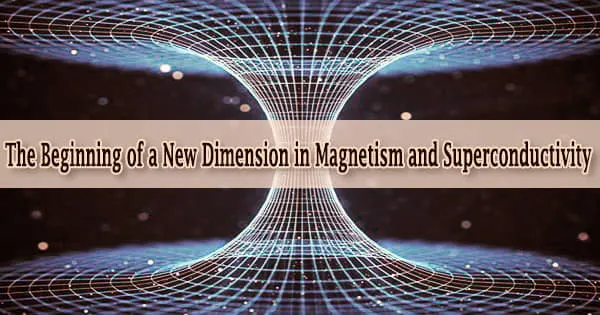A multinational team of scientists from Austria and Germany has initiated a new paradigm in magnetism and superconductivity, focusing next-decade research on the impacts of curvature, topology, and 3D geometry. (A new paper appears in the journal “Advanced Materials.”)
One aspect of the combined electromagnetic force is magnetism. It refers to physical events that occur as a result of the force exerted by magnets, which are devices that generate fields that attract or repel other objects. The theory of general relativity has traditionally been the principal field in which curvature has played a key role.
Curvilinear geometry’s influence has recently spread across a variety of disciplines, from solid-state physics to soft-matter physics to chemistry and biology, spawning a slew of new domains such as curvilinear cell biology, semiconductors, superfluidity, optics, plasmonics, and 2D van der Waals materials.
Magnetism affects all materials, albeit some are more magnetized than others. The strongest effects, known as ferromagnetism, are seen in permanent magnets made of materials such as iron.
Because of geometry, curvature, and topology-induced effects, extending nanostructures into the third dimension has become a key study path in modern magnetism, superconductivity, and spintronics. By adjusting the curvature and 3D shape, this method allows for the improvement of existing and the introduction of new functionality.
A charge passes through a material without resistance, which is known as superconductivity. Theoretically, this allows electrical energy to be transported between two sites with perfect efficiency and no heat loss.
“In recent years, there have appeared experimental and theoretical works dealing with curvilinear and three-dimensional superconducting and (anti-)ferromagnetic nano-architectures. However, these studies originate from different scientific communities, resulting in the lack of knowledge transfer between such fundamental areas of condensed matter physics as magnetism and superconductivity,” says Oleksandr Dobrovolskiy, head of the SuperSpin Lab at the University of Vienna.
“In our group, we lead projects in both these topical areas and it was the aim of our perspective article to build a “bridge” between the magnetism and superconductivity communities, drawing attention to the conceptual aspects of how extension of structures into the third dimension and curvilinear geometry can modify existing and aid launching novel functionalities upon solid-state systems.”
“In magnetic materials, the geometrically-broken symmetry provides a new toolbox to tailor curvature-induced anisotropy and chiral responses,” says Denys Makarov, head of the department “Intelligent Materials and Systems” at the Helmholtz-Zentrum Dresden-Rossendorf.
In recent years, there have appeared experimental and theoretical works dealing with curvilinear and three-dimensional superconducting and (anti-)ferromagnetic nano-architectures. However, these studies originate from different scientific communities, resulting in the lack of knowledge transfer between such fundamental areas of condensed matter physics as magnetism and superconductivity.
Oleksandr Dobrovolskiy
“One of the key advantages of curvilinear magnetism, which has a large impact on physics, material science, and industry, is the ability to control magnetic responses by designing the geometry of a wire or magnetic thin film. Curvilinear ferro and antiferromagnetism, curvilinear magnonics, and curvilinear spintronics are currently included under the fundamental field of curvilinear magnetism.”
“The key difference in the impact of the curvilinear geometry on superconductors in comparison with (anti-)ferromagnets lies in the underlying nature of the order parameter,” expands Oleksandr Dobrovolskiy.
“In contrast to magnetic materials, which need the analysis of energy functionals having spatial derivatives of vector fields, superconductors require the study of energy functionals including spatial derivatives of scalar fields. While the magnetization (vector) is the order parameter in magnetism, the absolute value of the order parameter in a superconducting state has a physical meaning: the superconducting energy gap (scalar).”
In the future, researchers will be able to investigate the interplay between curvature effects in systems with vector and scalar order parameters by extending hybrid (anti-)ferromagnet/superconductor structures into the third dimension. This progress, however, is heavily reliant on the development of experimental and theoretical methodologies, as well as the advancement of computational capacities.
Challenges for investigations of curvilinear and 3D nanomagnets and superconductors
When the system’s sizes or features grow equivalent to the respective length scales, curvature and torsion effects are expected. Writing complex-shaped 3D nano-architectures using focussed particle beams has made the most progress among the many nanofabrication techniques in recent years, making these approaches the techniques of choice for basic and applications-oriented studies in 3D nanomagnetism and superconductivity.
However, existing experimental capabilities are still unable to approach important length scales in the low nm range (exchange length in ferromagnets and superconducting coherence length in nanoprinted superconductors).
Simultaneously, sophisticated tools for characterization of magnetic configurations and dynamics in complex-shaped nanostructures, such as X-ray vector nanotomography and soft X-ray laminography, are becoming accessible.
Similar studies of superconductors are more sensitive because they require cryogenic settings, making them intriguing for future research.





